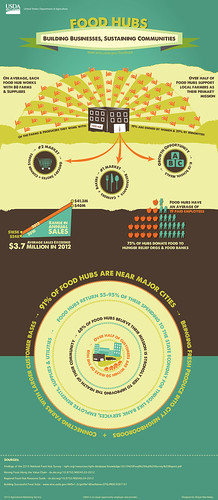
Food is a great equalizer. Whether sharing it with loved ones around our holiday table or worrying about how we’re going to fit lunch in to our busy work days--food is something we all have in common. But we don’t always think about the path it takes to get to our plates or even the store shelves. And while there are many different ways it gets to us, we’re seeing food hubs play an increasingly important role for everyone along the way--farmer to corner store, chef to school lunch.
Food hubs are innovative business models emerging more and more across the country. They bring farmers and suppliers together, with 81 percent of food hubs focusing on increasing opportunities for local farms and allowing smaller producers to pool their products and fulfill larger contracts. Ninety-one percent of food hubs are near cities, connecting rural farmers to larger suburban and urban communities. Oftentimes, farmers who work with food hubs offer a wider variety of products and are able to continue selling their goods later into the growing season. That translated into an average of over $3.7 million in sales in the last year. And USDA’s efforts have helped expand the number of regional food hubs operating around the country. There are over 230, a 65 percent increase since 2009.
Seventy-six percent of food hubs work almost exclusively with small-to-mid-sized growers. Without that support, many of these farmers would not have enough capital to own their own trucks, refrigeration units or warehouse space. By working together through the food hubs, they support each other while building their business. It’s a recipe for financial success that helps sustain the local community in a major way. USDA’s Regional Food Hub Resource Guide, released by the Agricultural Marketing Service (AMS) in 2012, gives lot of good information on food hubs and how they support the growth and development of regional food systems.
For many food hub participants, there’s an understanding that the growth of their business can be tied to the improving health of their local community. And they take the opportunity to put that belief into practice. For example, 75 percent donate food to hunger relief organizations and food banks. Forty-seven percent offer cooking and nutrition education within the community. And 52 percent believe that supporting area farmers is their primary mission. They also contribute to their state’s economic bottom line, returning 55 to 95 percent of their spending locally through bank services, employee benefits, supplies and utilities.
That’s not to say that there aren’t some challenges. Like any modern business, food hubs face some common challenges. Managing smart growth while balancing supply and demand is a tough line to walk. Part of that includes increasing staff when needed and securing enough product. But the entrepreneurial spirit that sustains the innovation of most food hubs is a great foundation to work from to better address these challenges.
Food hubs are helping producers of all sizes grow and thrive, which in turn supports the economic health and well-being of our diverse local communities. USDA is a proud supporter of food hubs and other players in the local food effort. We’re committed to understanding this model, how they serve communities and how we can help them continue to succeed.
To help show the rapid growth of the local food market across the nation, USDA created the Know Your Farmer, Know Your Food Compass – an online tool illustrating the many places USDA has supported these opportunities nationwide.
In addition to creating a food hub portal, that includes a collection of research news and information, AMS released its 2012 report: Moving Food Along the Value Chain: Innovations in Regional Food Distribution report. The report provides information on how producers can tap into the growing commercial demand for local and regional food, create additional economic opportunities and expand access to healthy food. You can also delve deeper into the food hub facts and figures cited in this blog and our infographic by reading the 2013 survey results published by Michigan State University.
The growth of our local markets also has an impact on folks who are new to the business of agriculture. As the average age of the American farmer increases, we need more new folks on the farm. Local and regional markets help these new farmers – who include returning veterans, immigrants and more women than ever before – get started and sell their product.
USDA intends to continue our record support for food hubs and other regional and local food systems and we’re committed to programs that serve all Americans. Whether it’s through offering loans, engaging industry leaders in policy discussions or helping open doors to new business opportunities, our goal is to make sure that we support all of U.S. agriculture. But to do so, we need a Food, Farm and Jobs Bill as soon as possible. A new Farm Bill would enable our continued efforts to expand farmers markets and food hubs, while expanding healthy food access for low-income Americans and kids in our schools. All of these efforts would benefit the rural economy, while helping to achieve new opportunity in agriculture in the years to come.
